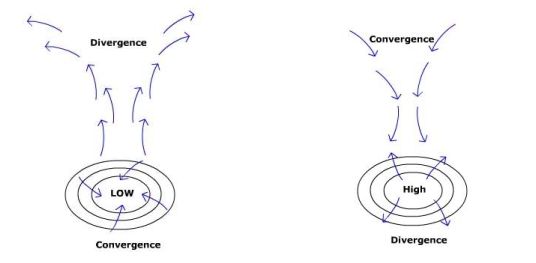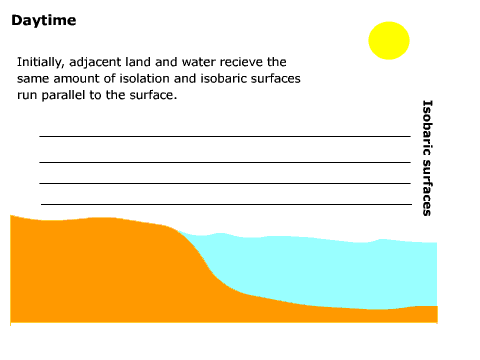Chapter Review


Chapter Review Assess your understanding of concepts related to this chapter by answering the questions below. Click the question to reveal the correct answer.
Cyclones: Air moves inward toward the center of a cyclone (converges) at the surface, then rises up and diverges from the top. In the Northern Hemisphere air moves in a counterclockwise direction at the surface while in the Southern Hemisphere the air moves in a clockwise direction.
Anticyclones: Air converges at the top, subsides toward the surface, then diverges outward. In the Northern Hemisphere air moves in a clockwise direction outward from the center at the surface. In the Southern Hemisphere the air moves in a counterclockwise direction at the surface.
Variations in air pressure across the surface can occur in two ways, by thermal and mechanical means. Thermal means require the heating or cooling of air. When air is heated it becomes buoyant and rises off the surface and lowers surface pressure as it circulates away. If air is chilled it can sink, building pressure at the surface. Surfeace features like mountains can slow air allowing it to build up and increase pressure.
Wind velocity is primarily a function of the pressure gradient force and surface friction. The greater the pressure greater the faster the wind. Rough surfaces impart friction to air and slow it down.
Monsoon means wind that changes direction with season. During the summer, the Asian continent warms more than the ocean creating lower pressure over land and higher pressure over water. The resulting pressure gradient causes wind to blow from over the ocean toward land. This is the wet monsoon period. During winter, the pattern reverses with higher pressure over land and lower pressure over water. Air now travels from over the land toward the ocean. This is the dry monsoon period.
The major ocean currents are wind-driven currents. Cold currents form in response to air blowing out of a subtropical high that passes over a cool pool of water dragging it equatorward. Warm ocean currents form in response to air blowing out of a subtropical high that passes over a warm pool of water dragging it poleward.
Ocean currents help redistribute heat across the Earth's surface. Warm ocean currents move heat gained in low latitudes toward high latitudes. Cold ocean currents moving equatorward help conduct heat out of the tropical atmosphere thus lowering low latitude temperatures. Ocean currents also affect precipitation. Cold ocean currents tend to make air stable thus inhibit precipitation formation. Warm ocean currents help to promote unstable conditions which enhance the likelihood for precipitation.
Land/sea breezes form along coast of major bodies of
water. A sea breeze occurs during the day as land warms more than
nearby water. The differential temperature pattern creates a
pressure gradient directed from over water (higher pressure) to land
(lower pressure). Air travels from over the water toward land. A
land breeze typically occurs at night when land cools more than
nearby water. This creates a pressure gradient oriented from over
the land (higher pressure) toward water (lower pressure).
 Generally speaking, low pressure is associated with moist conditions while high pressure is associated with dry conditions. The ITCZ creates moist conditions in the low latitudes by promoting converging air masses. The subtropical high creates dry conditions in the subtropics like those found in the great deserts of the Earth (e.g. Sahara). In the midlatitudes the presence of the subpolar low and polar front jet stream creates humid conditions. Over the poles, the subsiding air of the polar high inhibits the creation of precipitation promoting dry conditions there.
Meridonal flow occurs when the jet stream and circumpolar vortex takes a North-South wave-like form transferring cold air equatorward and warm air poleward. When the edge of the circumpolar vortex and jet stream is flatter and exhibits an west to east flow it is called zonal flow.
The jet stream provides support for the formation and life-cycle of surface pressure systems. Regions of convergence and divergence are found in the jet stream. Some surface cyclones form beneath zones of diverging air aloft while surface anticyclone can form beneath zoned of converging air aloft.
|